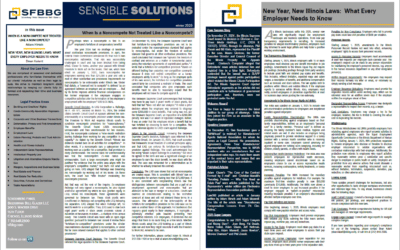Finding, grooming, and ultimately selling your business to one or more key employees is a process that typically takes several years. Once you have found the right successors, proper succession planning often involves two additional steps. The first step is often to give the successor owners some initial equity in your company. This not only offers him or her some “pride of ownership,” but it also provides the existing owner(s) someone to continue to operate the business. When transferring an ownership interest to your successor(s) the transfer should be accompanied by an agreement among the company and all of its owners regarding the disposition of each owner’s interest in the company upon the occurrence of certain events, such as an owner’s death, permanent disability, or retirement (with the restrictions on transfer noted on the stock certificate).
For purposes of this article, we will assume that the business is a corporation. Although the following discussion generally applies to other types of entities as well, it is important to note that the tax treatment can vary substantially depending on how the entity has elected to be taxed.
There are typically two ways to provide key employees with stock. The company can either (a) sell stock to the key employees, or (b) issue stock to the key employees as compensation for services. An employee who owns stock will have all of the rights of a stockholder in the company, including the right to vote (if the stock is voting stock), and the right to examine the books and records of the company for any proper purpose. In addition, to the extent that the company pays dividends, such dividends must be paid pro rata to all of the company’s stockholders within the same class of stock.
(a) Selling Stock. This is very straight-forward, but often not very appealing to many employees. The amount received by the company from the sale of its stock is a capital contribution to the company and not income to the company. A purchase of stock by an employee will not result in income to the employee except in the case of a bargain sale, i.e., where the purchase price is less than the fair market value of the stock. In the case of a bargain sale, the employee will realize ordinary income equal to the excess of the fair market value of the stock over the price he or she paid for the stock.
(b) Issuing Stock as Compensation for Services. Stock issued by a company as compensation for services represents ordinary income to the employee in an amount equal to the fair market value of the stock. This same amount is also fully deductible by the company as an ordinary business expense for the same year in which the employee takes the value of the stock into income. The employee can defer taking the value of the stock into income if the stock is subject to a substantial risk of forfeiture, as, for example, where the employee’s right to the vesting of the stock is conditioned on the performance of services for some period of time. Once the stock is no longer subject to a substantial risk of forfeiture, however, the employee must then recognize its then fair market value as ordinary income. Since this may result in a significant tax liability, companies often also pay a cash bonus to the employee to cover his or her tax liability.
(c) Shareholders Agreement. When your company is transferring some of its stock to one or more key employees, it is important that the company and all of its stockholders enter into an agreement which governs what happens to a stockholder’s stock in the company upon the happening of certain events. The typical stockholders’ agreement will cover all of the following:
(1) Restrictions on Transfer. The stockholders’ agreement should restrict a stockholder’s right to sell his or her stock in the company. The typical ways of accomplishing this include the right of first refusal, right of first offer, or the requirement that the other stockholders consent to the transfer. Keep in mind that the complete prohibition upon transfer is likely to be unenforceable.
(2) Death. Death will give rise to the obligation of the deceased stockholder’s estate to sell, and the company to buy, the stock of the deceased stockholder. This is done in order to provide the estate with liquidity and to prevent a deceased stockholder’s heirs from owning stock in the company. The purchase price in the case of death should be the fair market value of the stock, with such fair market value to be determined based upon the formula or methodology set forth in the agreement. The purchase price can be funded wholly or in part by life insurance maintained by the company on the lives of its stockholders, assuming that it is not cost-prohibitive to do so. The company need not maintain life insurance on all of the stockholders. If there is life insurance on a deceased stockholder, the purchase price will be paid out of the policy proceeds, with the balance, if any, paid over time. If the proceeds exceed the purchase price, the excess belongs to the company.
(3) Permanent Disability. Permanent disability will give rise to the obligation of the disabled stockholder to sell, and the company to buy, the stock of the disabled stockholder. This is done in order to provide the disabled stockholder with liquidity, and to prevent a disabled stockholder from owning stock in the company, since the disabled stockholder is no longer capable of rendering services to the company. The purchase price in the case of permanent disability should be the same as that used in the case of death. The proceeds of any disability insurance received by the disabled stockholder does not typically reduce the purchase price, however, since this is intended to compensate the disabled stockholder for lost income. Accordingly, the entire purchase price is typically paid over time.
(4) Retirement. Retirement will give rise to the obligation of the retired stockholder to sell, and the company to buy, the stock of the retired stockholder. This is done in order to provide the retired stockholder with liquidity, and to prevent a retired stockholder from owning stock in the company, since the retired stockholder is no longer rendering services to the company. The purchase price in the case of retirement should be the same as that used in the case of death or permanent disability. Retirement is typically defined as a stockholder’s voluntary resignation as an employee of the company after having reached a certain age and after having given the company sufficient notice. Again, the entire purchase price is typically paid over time.
(5) Divorce. Divorce may give rise to the obligation of the affected stockholder to sell, and the company to buy, the stock of the affected stockholder. This is done in order to prevent a stockholder’s former spouse from owning stock in the company, though the stockholders’ agreement will restrict this type of transfer. The purchase price in the case of divorce should be discounted from the fair market value of the stock, with such discount being set forth in the agreement. The purchase price should be paid over time.
For more information or any questions, please contact Len Gambino at [email protected], or call 312-648-2300.



